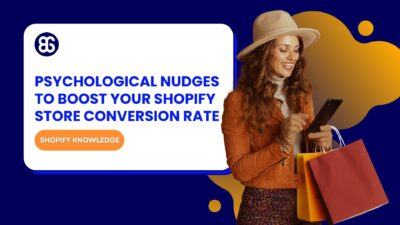
3 Simple Psychological Nudges To Boost Your Shopify Store Conversion Rate
The “Add to Cart” click is a good start, but high cart abandonment rates-70-80%-prove the completed purchase is the...
Digital Marketing Specialist
Bundle Pricing is ubiquitous. You know when you have to buy a coffee machine with a bag of coffee beans in it, or a skincare set with a contact remover, concentrate, and moisturizer, at a discounted price compared to when each container is purchased separately.
This bundling scheme can make the customers feel more satisfied about their purchase and provide the stores with a means of increasing sales, whetting the prospect of upselling, and clearing their shelves.
This guide will break down the underlying psychology behind it, outline the situations where it’s most effective, and also provide convenient methods for implementing bundles on Shopify that yield tangible results!
Product bundle pricing is a strategy where multiple products are packaged and sold together at one combined price, usually lower than the total cost of buying each item separately.
There are a few simple examples of how Shopify stores use bundling pricing every day:
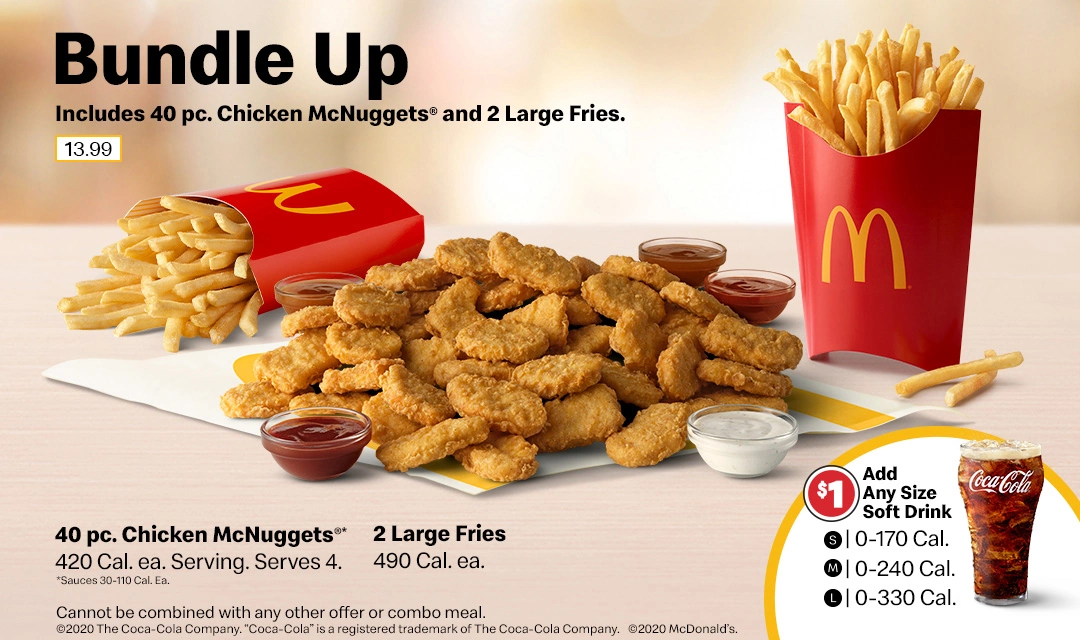
By using these bundles strategically, merchants can trigger upsell and cross-sell moments that feel effortless to customers.
Why does bundle pricing work so well beyond the obvious price cut? Now I will spill the beans.
Perceived value enhancement is the idea that a bundle feels more valuable than the individual pieces on their own. Customers believe they’re getting a better deal, even if the discount is modest, because bundling sparks that familiar “bargain instinct.”
When stores make the savings obvious (like saying “Save $20 when you grab the bundle”), the effect becomes even stronger. Vistevas, a health and wellness brand, offered simple bundles of two, four, or six pieces. The clearer value made shoppers buy more — conversions rose 20%, the add‑to‑cart rate went from 6% to 8%, and revenue grew by $104,687.
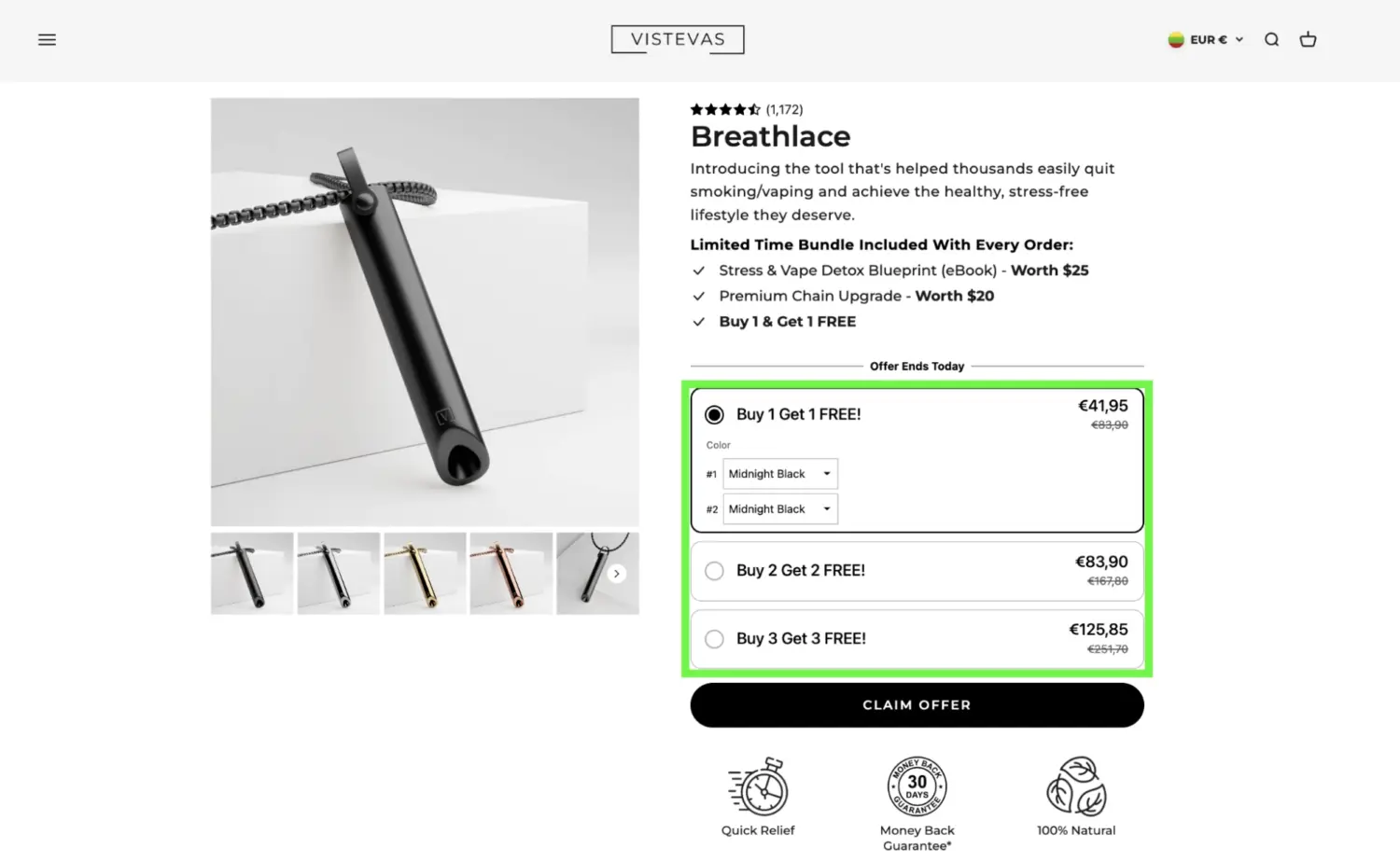
Decision fatigue happens when too many choices drain a shopper’s mental energy, leading to poorer or rushed decisions. Cognitive simplification is the relief they feel when the process is made easier — like when a bundle offers a single, ready-made option instead of forcing them to select each product one by one.
A Food Journal study even found that under high cognitive load, shoppers were nearly four times more likely to choose a bundle, even without a discount, simply because it made the decision less taxing.
Loss aversion is the idea that people feel the sting of losing something more strongly than the joy of gaining it. Bundles tap into this by making shoppers think about the savings or extras they’d “lose” if they didn’t take the offer. Add a time limit, and that fear of missing out grows, nudging customers to grab the bundle before the deal disappears.
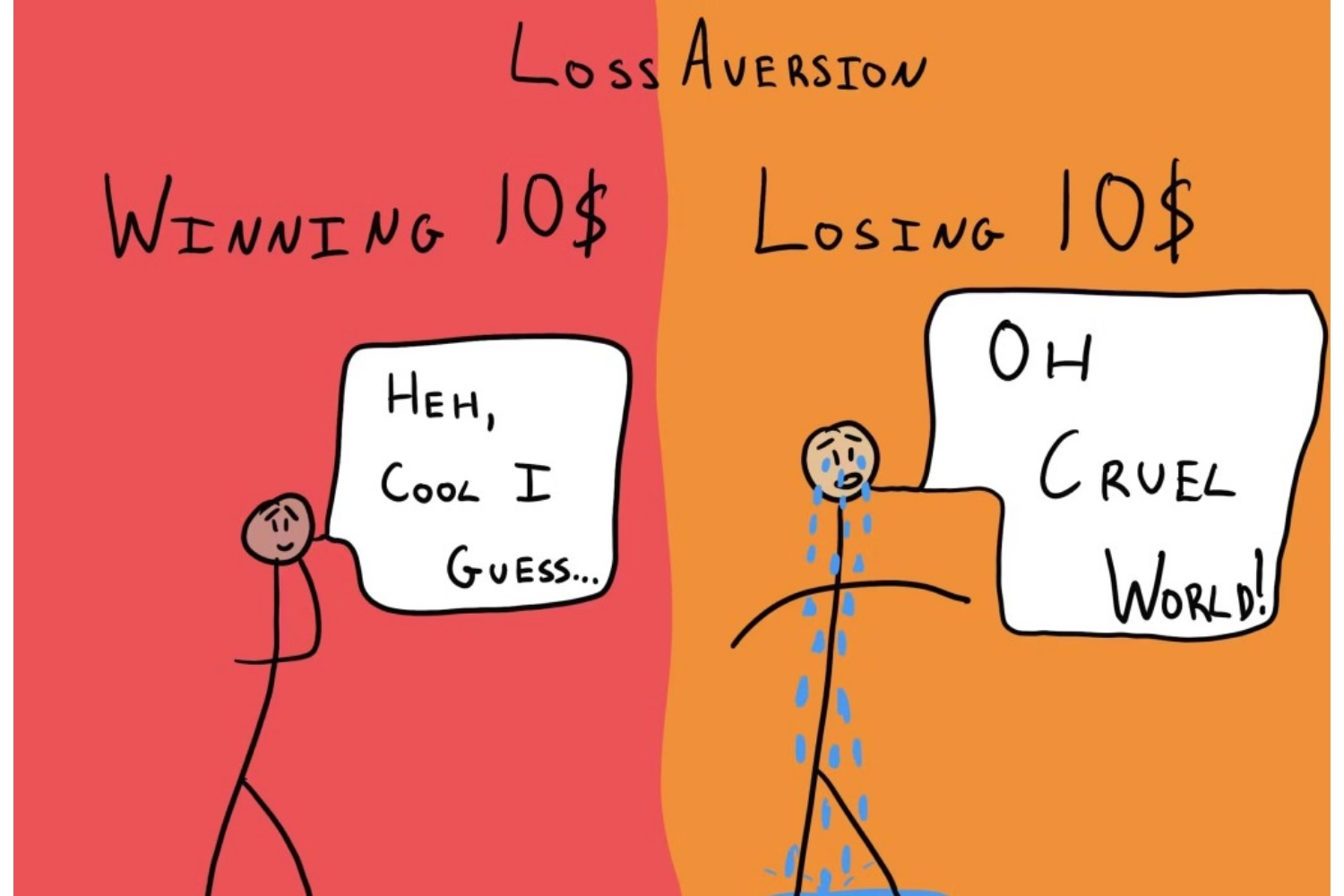
Are these three “psychological magnets” enough to make you confident about running bundle campaigns that could dominate the market in the future? If so, get ready — next, we’ll look at when to use bundle pricing.
Product bundling works best when it’s tied to a clear goal. Ready to grab a bundle when you want to:
Bundle pricing encourages shoppers to add more by showing them extra value. McDonald’s proved this with its all‑day breakfast — customers came for an Egg McMuffin and left with fries or a drink too. In fact, 61% added extra items, showing how the right bundle can quietly grow each order.
Customer acquisition is becoming increasingly expensive, making bundling a smart way to earn more from your existing visitors. Amazon Prime is proof. What began as a $79 shipping perk evolved into a comprehensive package that included streaming and Kindle access. As a result, members spent about 150% more after joining, recognizing the real value in this bundle.
Overstocked shelves or slow‑moving items don’t have to stay stuck. Nintendo proved how smart bundling clears bottlenecks — pairing Game Boy consoles with games sold together boosted hardware sales by about 100,000 units and pushed game sales up by more than a million. Offering bundles alongside individual items moves lagging stock faster while keeping customers happy with choice.
Customers often stick to what they know, but bundle pricing nudges them to explore. Adobe Creative Cloud is a masterclass in this strategy — instead of selling Photoshop or Illustrator separately for $20/month each, Adobe bundled every tool into one $52.99/month package. Finally, revenue climbed, engagement spiked, and customers began trying apps they’d never used before, leading to higher retention and lower churn.
When setting up bundles on Shopify, there’s no one-size-fits-all bundle pricing strategy. Different ones work for other products, customers, and goals. Below are five practical ways to price and present bundles, complete with real brand examples and best practices, to help you choose the right fit for your store.
Pure bundling refers to the fact that some goods are exclusively offered and only as a fixed set of components, at a stated reduced price. It makes it easier to decide on the customers and enables the brands to clear their stocks quickly.
Example: The Spectrum 4 in 1 Curling Tong is a true pure bundle. This features four interchangeable barrels, a heat glove, and a mat in one package at a price of £139.99. They are not sold individually on the same page, which makes customers view it as the entire styling solution.
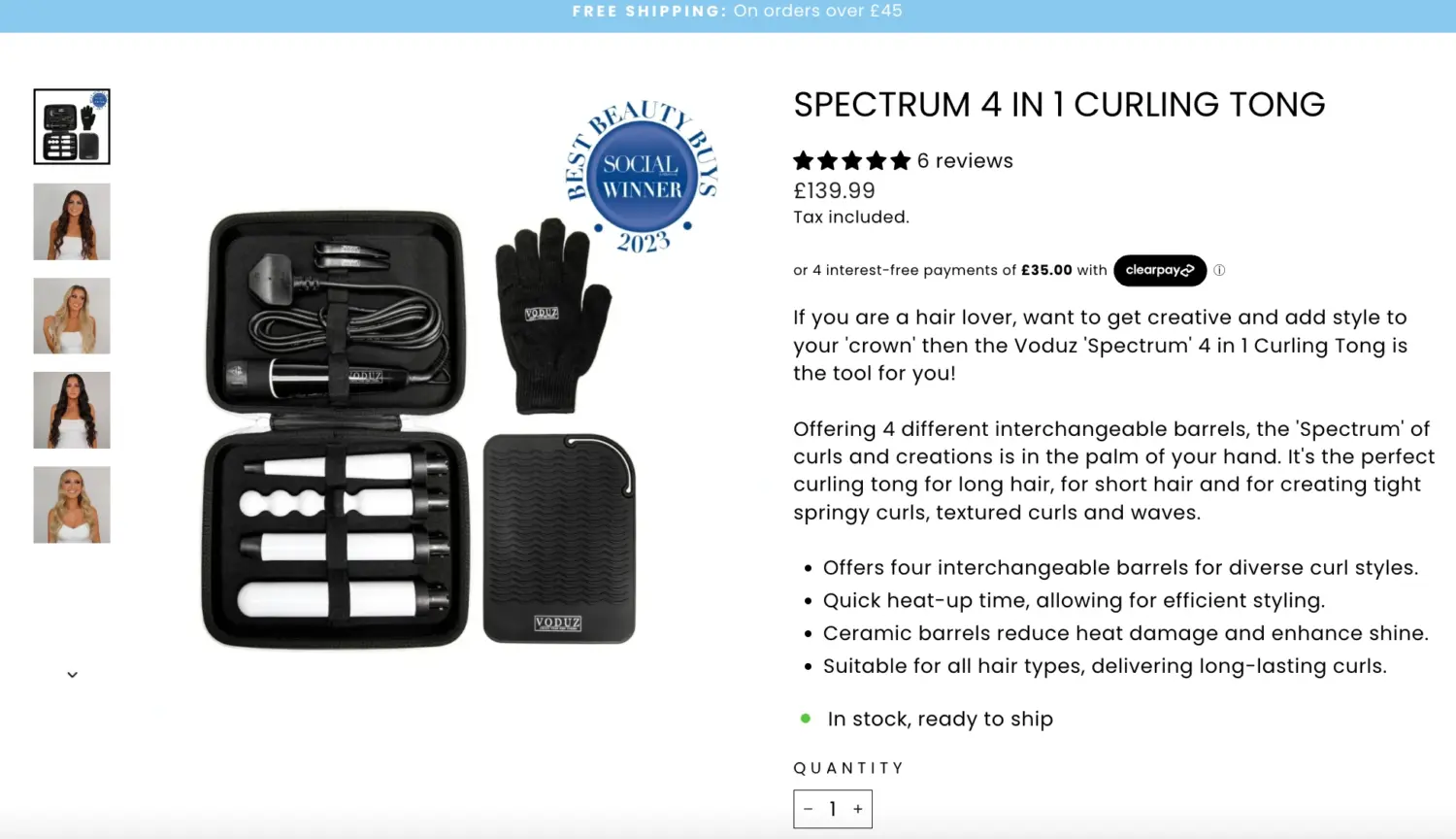
Best for: Starter kits, complete sets (like toolkits, electronics kits), or products that naturally belong together.
Best Practices:
Mixed bundling lets customers buy items separately or grab the bundle at a discounted rate. This provides flexibility and is great for shoppers who want only one item, while still enticing deal-seekers.
Example: Kylie Cosmetics’ Glossy Lip Kit & Skin Tint Blurring Elixir Duo shows mixed bundling in action. Each item can be bought alone, but the bundle price ($60.30 instead of $67) gives customers a clear incentive to buy both.
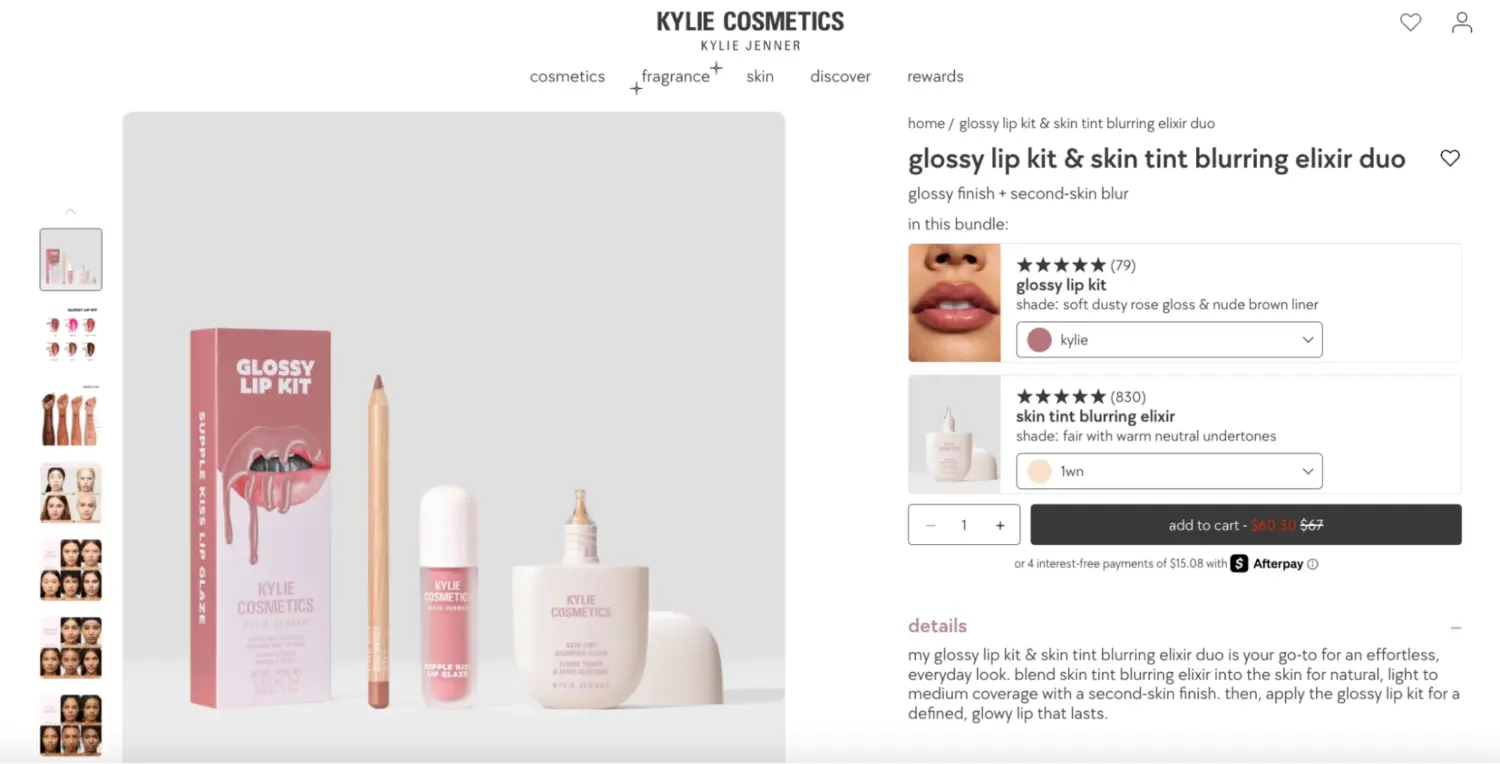
Best for: Beauty, fashion, and lifestyle brands looking to upsell without forcing shoppers into bundles.
Best Practices:
This strategy gives customers control. They can mix and match from a selection, with discounts applied as more items are added.
Example: The Esmi Skin Treats Tri Bundle lets customers pick any three serums for a flat $40. This customization feels personal and encourages bigger baskets.
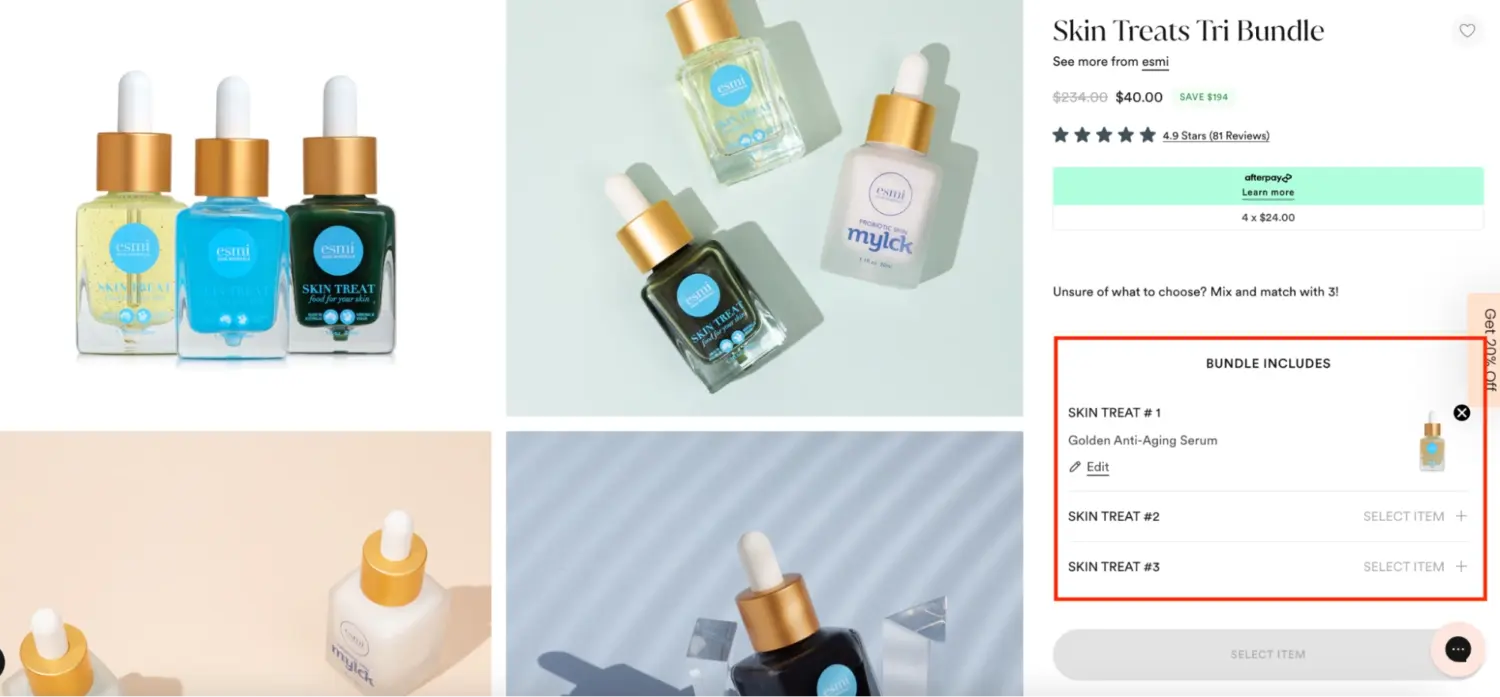
Best for: Brands with an extensive product range, like skincare, snacks, or apparel, where personalization adds value.
Best Practices:
Tiered bundling offers multiple levels (Basic, Standard, Premium) with increasing value and discounts. It taps into the “compromise effect”: shoppers tend to pick the mid-tier because it feels like the smartest choice.
Example: The Pack of Greeting Cards shows tiered pricing clearly: 5–10 cards (no discount), 11–21 (10% off), 21–31 (20% off). The structure encourages customers to buy more to hit the next tier.
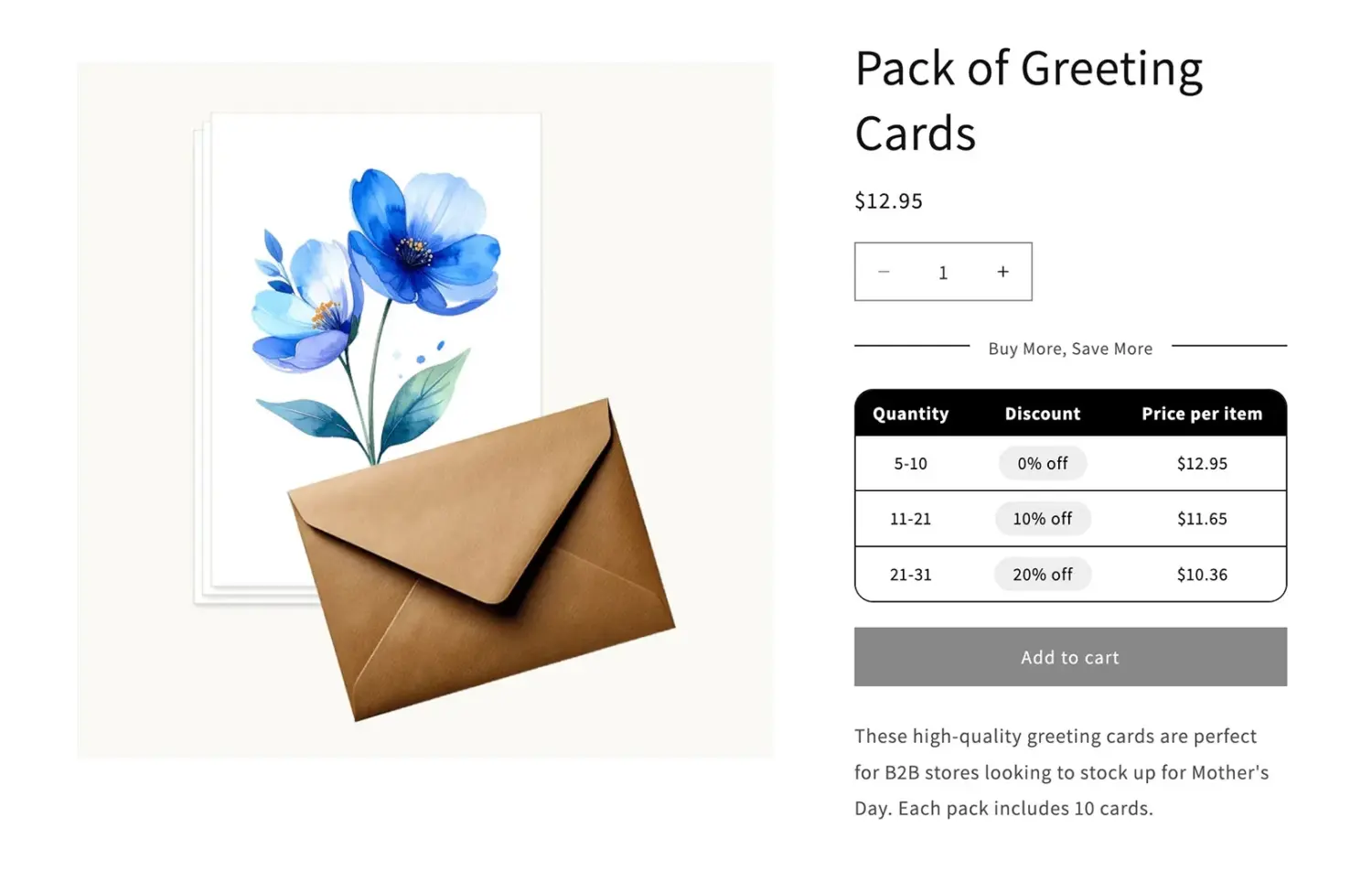
Best for: Consumables, stationery, or B2B items where customers often buy in bulk.
Best Practices:
These bundles are designed for a theme, event, or time of year, like holiday sets, back-to-school kits, or new product launch packs. They create urgency and tap into seasonal shopping habits.
Example: The Back to School Bundle in Pink is a classic purpose-driven bundle: a backpack, teen emergency kit, period kit, and bento box packaged together for $99.99, marketed as a complete school-ready set.
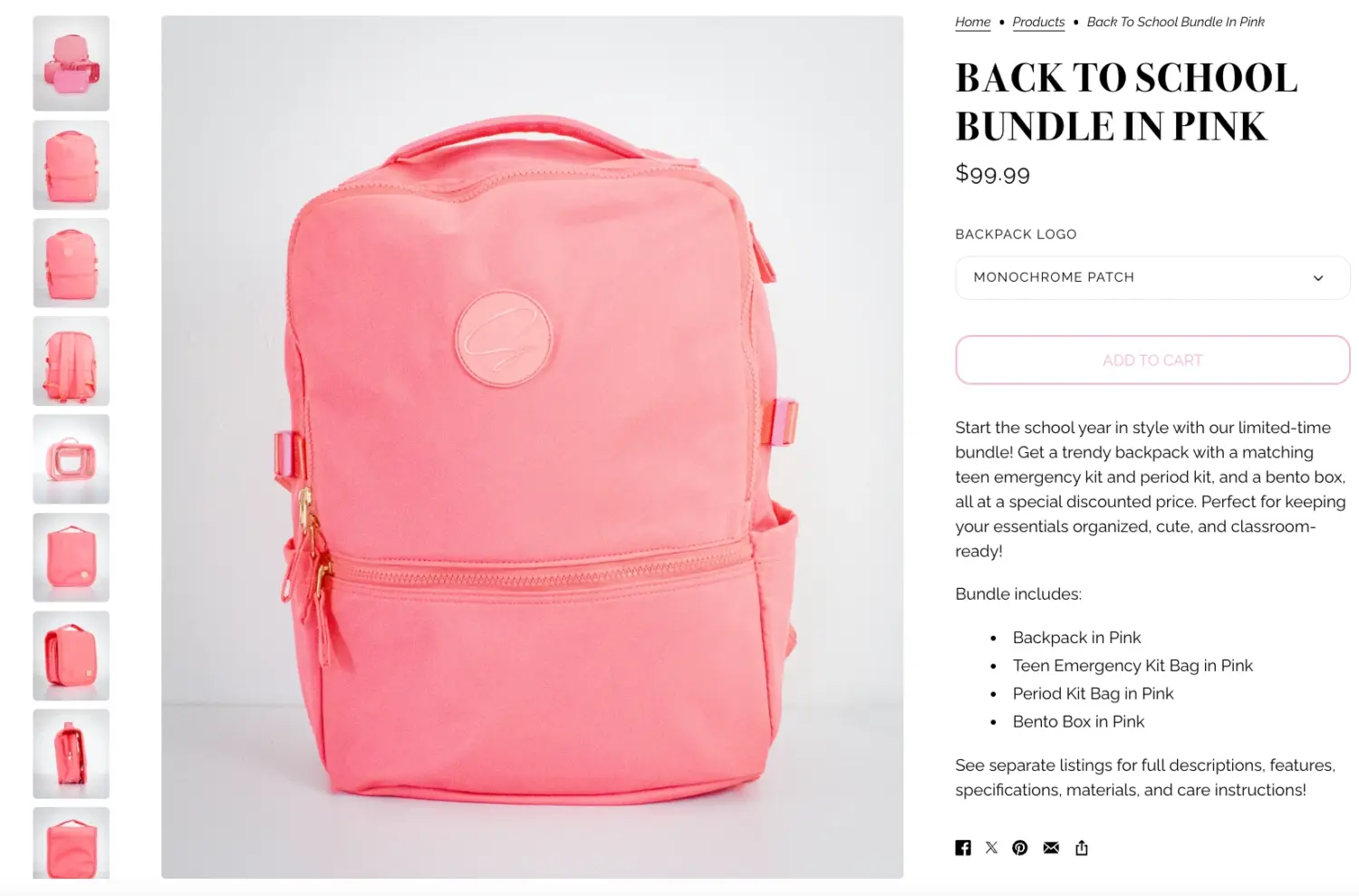
Best for: Holiday campaigns, back-to-school promotions, product launches, or lifestyle-focused kits.
Best Practices:
👉 Read more: 10+ Smart Bundle Pricing Examples for Shopify Stores in 2025
Creating a bundle in Shopify involves more than just combining products to attract customers; it is about developing an offer that is overwhelming to the client and profitable to your store, all while requiring minimal backend work. And this is how to do it step by step, with real-life tips at each step.
Start by picking items that make sense together. Look at your store analytics to see which products are frequently bought together, and think about how to solve a complete customer problem rather than just grouping random items.
For example, if you sell beauty products, consider bundling a cleanser, toner, and moisturizer into a complete skincare routine. Use these guiding questions:
Bundle type is critical as it determines how customers interact with your offer, how discounts are applied, and how your backend handles inventory. Choosing the right type early will save headaches later — from managing stock levels to setting up promotions — and ensures the bundle actually fits your store’s goals.
The main bundle types have already been covered in the strategy section, so simply refer back to that part for guidance on which approach best fits your store.
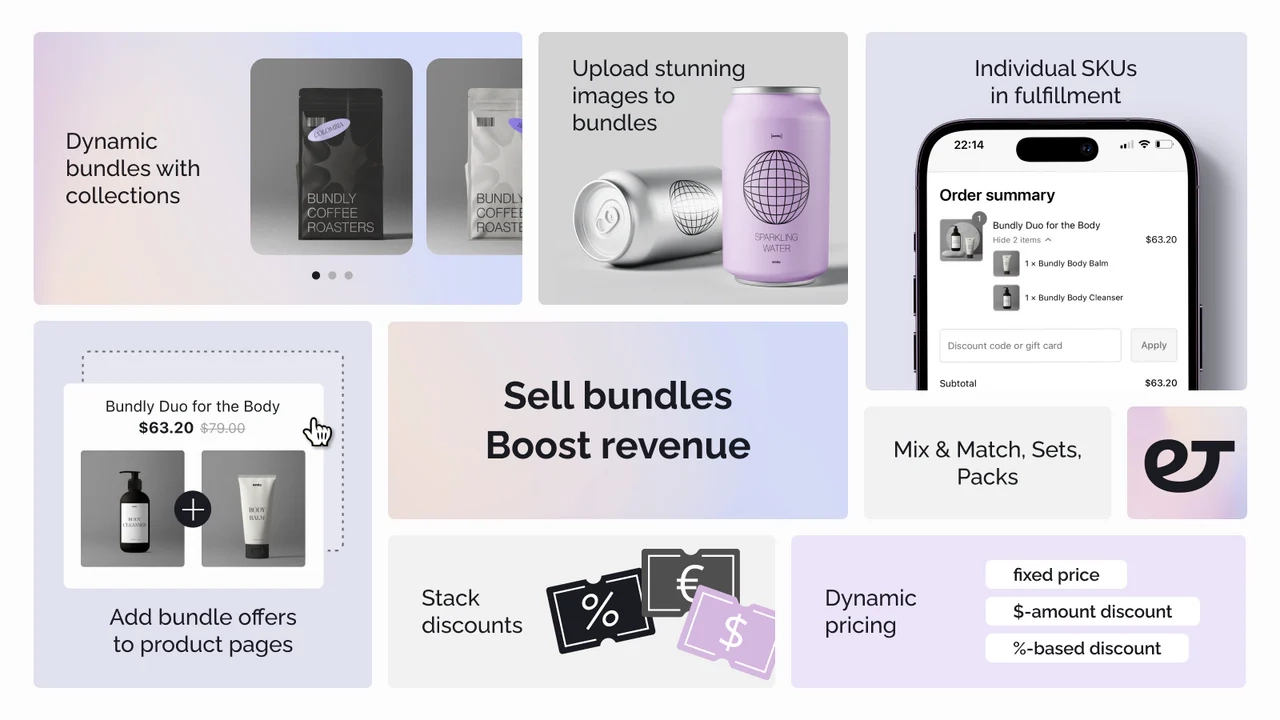
👉 Explore all types of bundle pricing you can create on Shopify & set-up guide here: [2025] A Beginner’s Guide to Shopify Product Bundles
Here I highly recommend BOGOS (4.9 ★ with 2,200+ reviews) — one of Shopify’s most trusted BOGO apps, but it also makes bundling easy — from Frequently Bought Together deals to fixed‑price bundles, mix‑and‑match offers, and even a full Bundle Builder page that can make your store look amazing.
Pricing is where many bundles succeed or fail. Follow these steps to get it right:
How you present your bundle can make or break sales. Add high-quality lifestyle images and a clear banner that shows the bundle value (e.g., “$89 value for only $69”). Keep the page clean and easy to scan:
Bundles can complicate your backend if not managed carefully. Ensure inventory updates automatically when bundled items sell, preventing accidental overselling of stock. For physical products, double-check shipping:
Once your bundle is ready, make it impossible to miss. Add it to your navigation, feature it on your homepage, and talk about it everywhere:
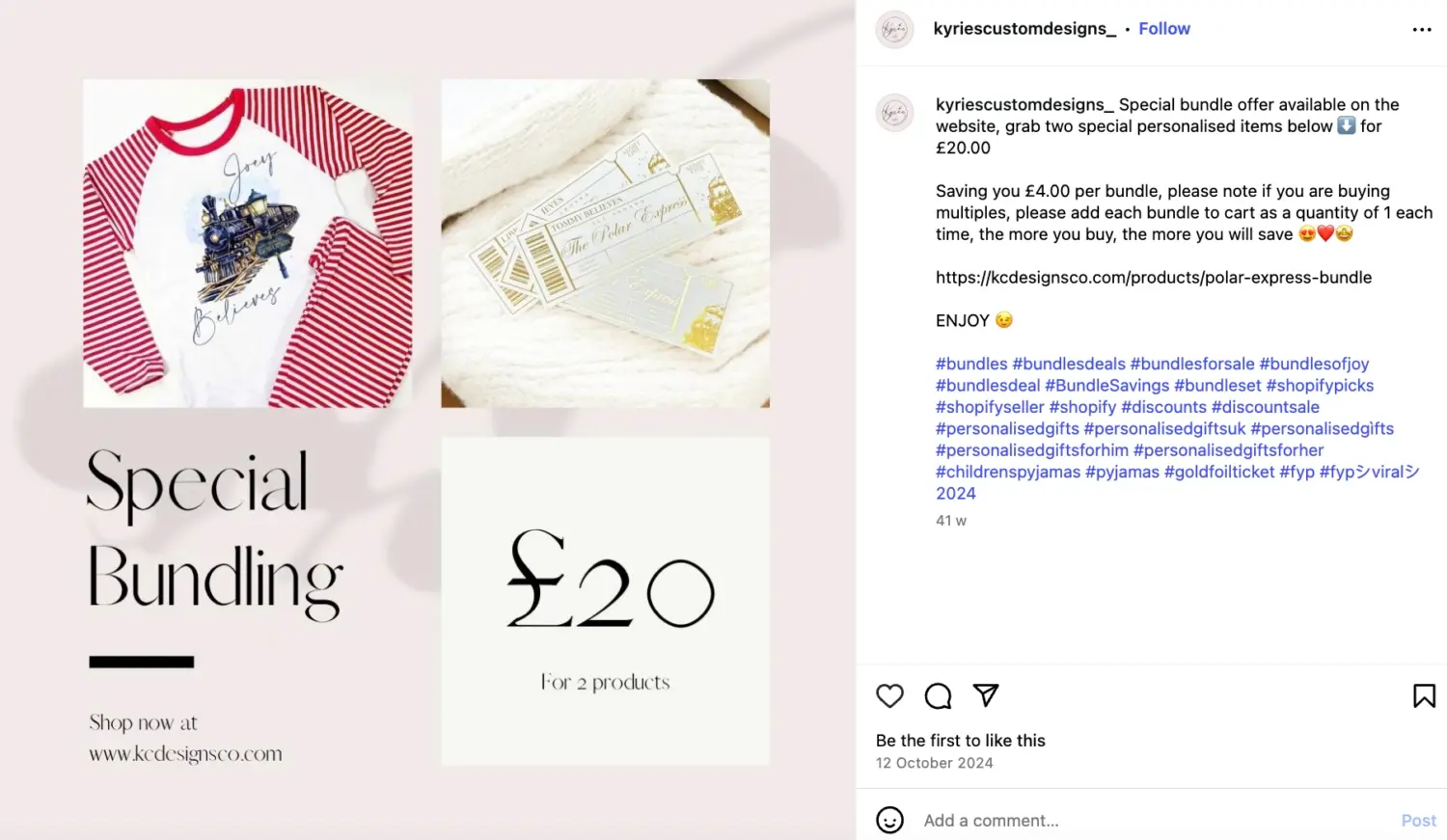
Your first bundle setup doesn’t stop there. It’s only the beginning. Keep tweaking, testing, and improving to see what really resonates:
| Common Mistake | How to Fix It |
|---|---|
| Bundling mismatched or irrelevant products | Bundle items that solve a clear customer problem (e.g., pillow + mattress) and use sales data to choose logical pairings. |
| Overpricing, under-pricing, or failing to show savings | Display both original and bundle prices, offer a visible 10–20% discount, and use psychological pricing like $49.99 instead of $50. |
| Complicated, unclear, or hidden bundle rules | Keep rules simple (e.g., “Buy 2, Get 1 Free”), show bundles on product pages and checkout, and limit items to 3–5 per bundle. |
| Poor inventory management | Use real-time inventory syncing, automated alerts, and “deny overselling” settings to avoid fulfillment issues. |
| Not highlighting bundle value & benefits | Use clear messaging like “Save 15% with this bundle” and visuals on product/cart pages to reinforce value. |
| Bundles competing with standalone product sales | Balance discounts with freebies or tiered rewards and segment bundles for specific customer groups. |
| Ignoring mobile optimization | Test bundles on multiple devices, adjust layouts, and simplify UI for small screens. |
| Failing to test, monitor, and optimize | Test the full buying journey, track analytics, and tweak bundles regularly based on performance. |
| Technical glitches with apps or storefronts | Test apps thoroughly, keep them updated, and contact support or Shopify experts when issues appear. |
In the end, the power of product bundling pricing lies in how naturally it encourages customers to buy more without feeling pressured. It frames your products as solutions, not just individual items on a shelf. By leaning on this strategy, you can increase profits and strengthen customer loyalty all at once.
– Analyze your product costs and margins before settling on a discount.
– Test different discount rates to see which maximizes both sales and profitability.
– Monitor performance and adjust the pricing accordingly. Don’t feel locked into one strategy
Yes, but it depends on how the bundle and discount are created. Some bundle apps treat bundles as draft orders, which may bypass Shopify’s automatic discount engine unless configured specifically in the settings.
– Calculate the combined retail value of all products in the bundle.
– Decide on a discount that’s sustainable for your margins:
If your average margin is 50% or more, a discount of 10–20% off the subtotal is common.
With margins below 50%, discounts are typically 5–10%.
– Always ensure that the final bundle price still preserves profitability.


The “Add to Cart” click is a good start, but high cart abandonment rates-70-80%-prove the completed purchase is the...
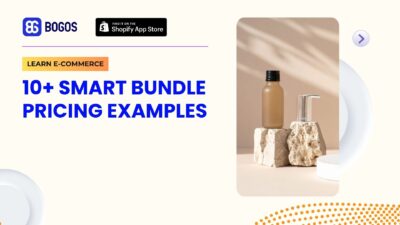
E-commerce in 2025 is noisier than ever, with shoppers overwhelmed by choices and brands competing for attention. That’s why...
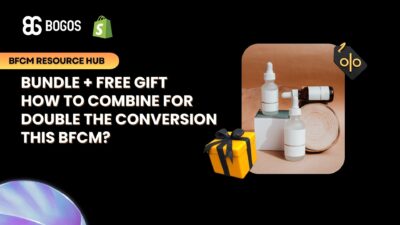
Does your BFCM sales spike quickly disappear, leaving you with a list of one-time buyers who never return? That’s...
